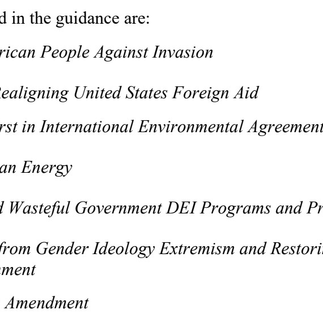The implications of this memorandum from the OMB extend far beyond its immediate administrative directives, with significant short- and long-term consequences for federal governance, societal equity, and public policy. Here's a deeper analysis of its broader implications:
1. Immediate Disruption to Federal Assistance Programs
The memorandum halts all federal financial assistance programs unless legally mandated, creating a ripple effect across multiple sectors:
Impact on Vulnerable Populations: Programs that provide essential services, such as housing, education, food assistance, and healthcare, could face delays or cancellations. Vulnerable communities, including low-income families, racial minorities, and LGBTQ+ individuals, are likely to be disproportionately affected.
NGO and Local Government Challenges: Many NGOs and state or local governments rely on federal grants to fund initiatives like disaster relief, environmental conservation, and public health campaigns. This pause could disrupt operations, forcing them to cut services or lay off workers.
Economic Ripple Effects: The halt could exacerbate economic instability by withholding critical funding streams, undermining local economies, and worsening unemployment in affected sectors.
2. Shift in Federal Policy Priorities
The memorandum signals a deliberate and ideologically driven reallocation of federal resources:
Deprioritization of DEI and Environmental Policies: Programs associated with diversity, equity, inclusion (DEI), and climate initiatives are explicitly targeted for reduction or elimination. This could reverse decades of progress on civil rights, environmental protection, and workplace equity.
Promotion of Administration-Aligned Initiatives: Redirecting funding toward domestic energy production and policies rejecting the Green New Deal aligns with a fossil fuel-centric agenda, potentially stalling the transition to renewable energy and worsening the climate crisis. Similarly, the focus on “biological truth” and rejection of “transgenderism” underscores an agenda to marginalize LGBTQ+ communities.
Increased Focus on Nationalist Goals: The emphasis on "boosting domestic energy" and reducing international environmental agreements signals a withdrawal from global cooperation, isolating the U.S. on key global issues like climate change and humanitarian aid.
3. Legal and Institutional Challenges
The memorandum's directives create legal and operational uncertainties:
Conflicts with Existing Laws: Many federal programs are governed by statutory obligations that require funding and administration regardless of executive orders. For example, Title IX mandates nondiscrimination based on sex, including protections for transgender individuals. Ignoring such obligations risks legal challenges from advocacy groups and states.
Litigation and Bureaucratic Paralysis: Lawsuits from affected stakeholders (e.g., NGOs, states, advocacy organizations) could delay program implementation and create uncertainty, further compounding the disruption.
Strain on Federal Agencies: Agencies must now conduct comprehensive program reviews, meet tight deadlines, and report compliance—all while under heightened political scrutiny. This could overburden staff, reduce efficiency, and create morale issues, especially for career civil servants.
4. Politicization of Federal Funding
The memorandum uses ideologically charged language—such as “Marxist equity,” “gender ideology,” and “transgenderism”—to justify the redirection of federal resources. This politicization has far-reaching consequences:
Erosion of Government Neutrality: Federal funding decisions historically aim to address broad societal needs. Shifting to overtly partisan priorities risks undermining public trust in government impartiality.
Disenfranchisement of Marginalized Groups: Targeting DEI initiatives and LGBTQ+ rights not only withdraws support but also sends a signal that the government views these communities and issues as unworthy of investment, exacerbating systemic inequalities.
Polarization of Policy Discourse: By framing funding priorities as a battle against "wasteful" or "woke" programs, the administration deepens partisan divides and fosters culture wars over critical social and environmental issues.
5. Potential Long-Term Effects
Undermining Climate Action: Rolling back funding for environmental programs and international agreements could delay progress on combating climate change, with consequences for future generations.
Chilling Effect on Advocacy: NGOs and other organizations may hesitate to apply for federal funding out of fear that their initiatives might be labeled "inappropriate," stifling innovation and advocacy in fields like social justice, education, and public health.
Concentration of Power: By requiring political appointees to oversee compliance with administration goals, the directive consolidates decision-making authority, marginalizing career civil servants and potentially creating a patronage system that favors political loyalty over expertise.
6. Broader Implications for Democracy and Governance
This memorandum reflects a broader effort to reshape federal governance along partisan ideological lines:
Erosion of Institutional Integrity: By prioritizing ideological conformity over the public good, the administration risks undermining the foundational principles of democratic governance.
Precedent for Future Administrations: This move sets a dangerous precedent, normalizing the use of executive power to enforce ideological purity and selectively fund programs. Future administrations—regardless of political affiliation—could exploit similar tactics to advance their own agendas, further eroding checks and balances.
Marginalization of Dissenting Voices: Labeling opposing ideologies as "Marxist" or "wasteful" delegitimizes debate and discourages dissent, fostering an environment of fear and conformity within federal agencies and funded organizations.
Conclusion
The OMB memorandum represents a profound realignment of federal priorities toward a narrow ideological vision, with immediate and long-term consequences for equity, governance, and public policy. While framed as a cost-cutting and efficiency measure, its true impact lies in the marginalization of vulnerable communities, the politicization of federal funding, and the erosion of democratic principles. Stakeholders, including advocacy groups, legal experts, and policymakers, must work proactively to challenge and mitigate the effects of these sweeping changes.
The OMB memorandum temporarily pausing all federal financial assistance programs and redirecting funds based on ideological criteria is likely illegal on multiple constitutional, statutory, and administrative grounds. The key legal violations are outlined below:
1. Violation of the Administrative Procedure Act (APA)
The Administrative Procedure Act (APA) of 1946 (5 U.S.C. §§ 551-559) governs how federal agencies implement policies. The OMB directive likely violates the APA in several ways:
Arbitrary and Capricious Standard (5 U.S.C. § 706(2)(A))
Under the APA, agency decisions must be reasonable, evidence-based, and not arbitrary or capricious.
Why it’s illegal:
The memorandum pauses all funding indiscriminately, without a clear legal or factual justification.
The decision appears politically motivated rather than grounded in law or necessity.
Targeting specific programs (DEI, climate, LGBTQ+ initiatives) based on political ideology rather than program efficacy violates neutral governance standards.
Courts have struck down similar administrative actions under the APA, such as when the Trump administration attempted to rescind DACA without sufficient legal reasoning (DHS v. Regents of the University of California, 2020).
Failure to Follow Proper Rulemaking Procedures (5 U.S.C. § 553)
The APA requires agencies to follow formal rulemaking procedures, including:
Public notice and comment periods for major policy changes.
Justification based on statutory authority and public interest.
Why it’s illegal:
This OMB directive does not go through rulemaking procedures.
No opportunity was given for affected entities to challenge the policy before implementation.
The executive branch cannot unilaterally halt statutory programs without due process.
2. Violation of Congressional Power over Federal Spending
The U.S. Constitution (Article I, Section 9, Clause 7) grants Congress sole authority over federal spending:
> “No Money shall be drawn from the Treasury, but in Consequence of Appropriations made by Law…”
This means:
The President cannot withhold or redirect congressionally appropriated funds without legal authorization.
Federal programs are funded through appropriations bills passed by Congress, not executive memoranda.
Why it’s illegal:
The OMB lacks the authority to unilaterally pause or terminate funding already appropriated by Congress.
Courts ruled against similar executive overreach in Trump v. Sierra Club (2020) when the administration attempted to redirect Pentagon funds for the border wall without congressional approval.
The Impoundment Control Act of 1974 (2 U.S.C. § 683)
This law prevents the executive branch from withholding funds appropriated by Congress, except under strict conditions.
Why it’s illegal:
The President must submit a rescission request to Congress, which must approve the cut.
Unilaterally blocking funds (even temporarily) violates this act.
Courts ruled against Trump’s withholding of military aid to Ukraine in 2019, reinforcing that the executive cannot override appropriations.
3. Violation of Civil Rights Laws
The directive explicitly targets programs related to diversity, equity, inclusion (DEI), and LGBTQ+ rights, likely violating multiple federal civil rights protections.
Title VI of the Civil Rights Act of 1964 (42 U.S.C. § 2000d)
Prohibits discrimination on the basis of race, color, or national origin in programs receiving federal assistance.
Why it’s illegal:
The memorandum’s broad attack on DEI programs suggests racial discrimination, as these programs exist to combat systemic inequities.
Title IX of the Education Amendments of 1972 (20 U.S.C. § 1681(a))
Prohibits sex-based discrimination in federally funded education programs.
Why it’s illegal:
Denying funding to programs supporting LGBTQ+ individuals (i.e., anti-"gender ideology" language) likely constitutes discrimination based on sex.
Courts have held that gender identity and sexual orientation are protected under Title IX (Bostock v. Clayton County, 2020).
Americans with Disabilities Act (ADA) (42 U.S.C. § 12101 et seq.)
Prohibits discrimination against individuals with disabilities.
Why it’s illegal:
Many DEI programs support people with disabilities.
Cutting such programs without justification could constitute disparate impact discrimination.
4. Violation of Environmental Laws
National Environmental Policy Act (NEPA) (42 U.S.C. § 4321 et seq.)
Requires federal agencies to consider environmental impacts before altering funding for environmental programs.
Why it’s illegal:
The memorandum abruptly halts federal environmental programs without proper environmental review.
Courts have ruled that agencies cannot revoke funding without conducting environmental impact assessments.
Clean Air Act & Paris Agreement Commitments
Why it’s illegal:
Defunding programs that support clean energy contradicts standing legal obligations under climate laws and international agreements.
5. Violation of the Equal Protection Clause (Fifth & Fourteenth Amendments)
The Equal Protection Clause ensures equal treatment under the law, and federal funding decisions cannot be based on ideological bias.
Why it’s illegal:
The memorandum discriminates against certain groups (racial minorities, LGBTQ+ individuals, climate scientists) by defunding programs tied to their rights.
Courts have struck down similar federal policies that unequally impact marginalized communities.
6. Violation of Federal Contracting Laws
Many grants and financial assistance agreements are binding contracts under the Federal Grant and Cooperative Agreement Act (31 U.S.C. § 6301 et seq.).
Why it’s illegal:
Arbitrarily canceling grants and awards violates existing federal contracts.
Agencies and grant recipients could sue for breach of contract.
Conclusion: The OMB Memo is Unconstitutional and Unlawful
The memorandum is legally indefensible on multiple grounds:
1. Violates the Administrative Procedure Act by being arbitrary, capricious, and procedurally improper.
2. Unconstitutionally usurps Congressional spending power in violation of the Impoundment Control Act.
3. Violates civil rights laws by defunding programs based on race, sex, gender identity, and disability.
4. Violates environmental laws by cutting climate-related funding without proper legal procedures.
5. Violates the Equal Protection Clause by using ideological bias to withhold funding.
6. Breaches federal contracting laws by illegally canceling grant obligations.
If challenged in court, this memorandum would almost certainly be struck down, as similar executive overreach has been ruled unconstitutional in cases like DHS v. Regents of UC (2020) and Trump v. Sierra Club (2020).
This directive is not just a policy shift—it is a direct assault on the rule of law and will likely trigger massive legal challenges from states, NGOs, universities, and advocacy groups.
Updated Legal Analysis of the OMB Memorandum Based on New Information
With the additional information provided, the OMB memorandum's legality remains questionable despite the administration's claim that it is a temporary pause rather than an impoundment. Below is a reassessment incorporating the justification from the memorandum and related executive orders.
1. Does the Pause Constitute an Impoundment?
The administration claims that the pause is not an impoundment under the Impoundment Control Act (ICA) of 1974, arguing that:
The pause is temporary to allow for program review.
Past presidents have issued similar pauses to align programs with new policy priorities.
Counterargument: It May Still Violate the ICA
The ICA prohibits the executive branch from withholding or delaying funds that Congress has appropriated unless it follows a legal rescission process.
Courts have ruled that an attempt to delay congressionally approved spending without congressional approval is an impoundment.
Precedent: Trump’s attempt to withhold military aid to Ukraine in 2019 was ruled a violation of the ICA.
OMB's claim that a temporary pause does not qualify as impoundment has not been upheld in court.
🔹 Legal Risk: If challenged in court, this pause could be deemed an unlawful impoundment because it halts funding without proper congressional authorization.
2. Does the Pause Violate the Administrative Procedure Act (APA)?
The memorandum’s justification states that this pause ensures programs comply with new administration policies, referencing executive orders such as:
Ending DEI Programs
"Restoring Biological Truth" in Government Policies
Realigning Foreign Aid
🔹 Potential APA Violations:
The APA (5 U.S.C. § 706(2)(A)) prohibits agencies from acting in an "arbitrary and capricious" manner.
Immediate suspension of funding without notice, rationale, or public comment period may violate APA standards.
Courts previously overturned Trump administration policies under the "arbitrary and capricious" standard (DHS v. Regents of the University of California, 2020).
🔹 Legal Risk: The memorandum could be struck down in court for failing to provide a legally sufficient justification under the APA.
3. Violation of Congressional Spending Authority
The U.S. Constitution (Article I, Section 9, Clause 7) grants Congress sole authority over federal spending.
While a president can influence budget priorities, they cannot unilaterally freeze or reallocate funds.
The executive branch cannot override Congress’s decisions on funding without approval.
🔹 Legal Risk: The broad nature of this pause, especially targeting specific ideological programs (DEI, gender policies, climate funding), suggests selective enforcement of congressional spending, which courts may rule unconstitutional.
4. Potential Civil Rights Violations
Several listed executive orders appear to specifically target federal programs related to:
Diversity, Equity, and Inclusion (DEI)
Gender identity policies
Environmental initiatives
🔹 Potential Violations:
Title VI of the Civil Rights Act (42 U.S.C. § 2000d) prohibits discrimination based on race, color, or national origin in federal funding.
Title IX (20 U.S.C. § 1681(a)) prohibits sex-based discrimination in federally funded programs.
Americans with Disabilities Act (ADA) (42 U.S.C. § 12101) prohibits funding discrimination against individuals with disabilities.
🔹 Legal Risk: If these funding pauses disproportionately impact marginalized groups, lawsuits could argue that the policy is discriminatory and violates federal civil rights laws.
5. Equal Protection Clause Concerns
The memorandum targets specific ideological programs under the justification of eliminating “radical” and “wasteful” programs.
Courts have ruled that government actions appearing to punish specific political or ideological viewpoints violate the Equal Protection Clause.
Example: Courts ruled that the Trump administration's attempts to defund sanctuary cities were unconstitutional due to selective enforcement.
🔹 Legal Risk: If plaintiffs prove the pause is ideologically driven rather than policy-neutral, courts could strike it down as a violation of the Equal Protection Clause.
6. Federal Contracting and Grant Law Breach
Many federal grants operate as legally binding agreements.
Sudden termination or modification of awarded grants could be a breach of contract.
Agencies are required to follow Federal Grant and Cooperative Agreement Act (31 U.S.C. § 6301 et seq.).
🔹 Legal Risk: If funding recipients sue for breach of contract, courts may rule that the OMB illegally canceled legally binding grant agreements.
Conclusion: Likely Unlawful Despite Justifications
While the administration argues that this is a temporary, lawful pause, courts may still rule that:
It functions as an illegal impoundment under the ICA.
It violates the APA due to lack of proper rulemaking procedures.
It usurps Congressional spending authority by blocking funding Congress approved.
It selectively targets programs in a way that could violate civil rights laws and the Equal Protection Clause.
Bottom Line: This memorandum faces a high likelihood of being struck down in court, as similar executive actions have been overturned under the Trump administration for violating constitutional and statutory limits on executive power.
https://bsky.app/profile/atrupar.com/post/3lgtf4w3z4k2m























